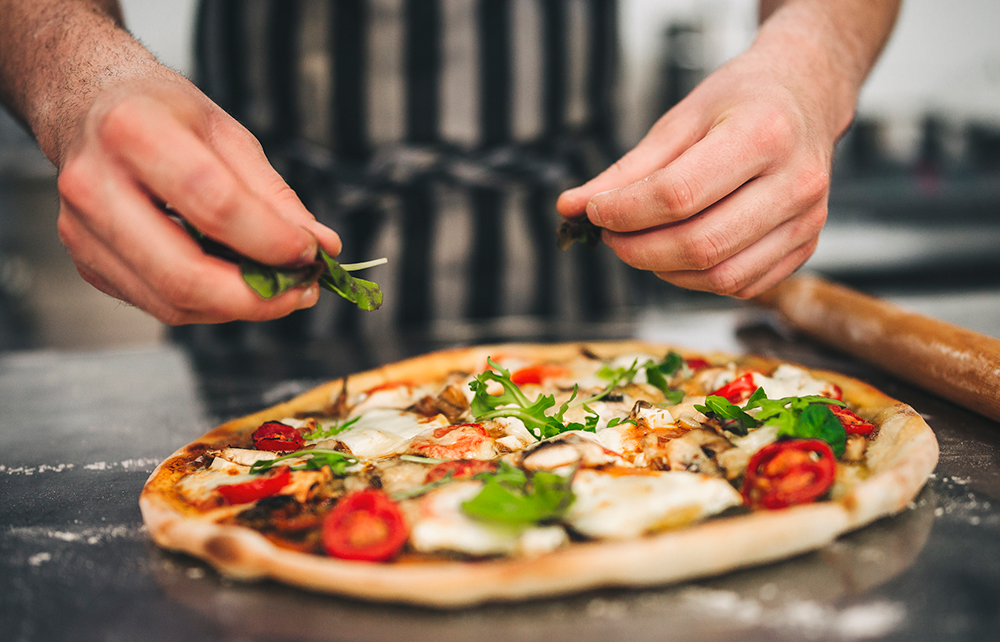Every year I’m summoned to a gathering which I strive to avoid. My first cousin, who loves a boozy party, assembles the extended clan in an Italian restaurant for a convivial lunch. I fear that my list of excuses – ‘back pain’, ‘gout’, ‘baptism in Scotland’, ‘last-minute undercover journalism assignment’ – is wearing a bit thin and I’ll have to show up this year.
No sane human could feel fondness for a cuisine whose leading dish, pizza, can’t be eaten with a spoon
It’s not my relatives that I dislike. It’s the stuff on the plates. No sane human could feel any fondness for a cuisine whose leading dish, pizza, can’t be eaten with a spoon. The most exquisite foodstuffs such as honey, caviar, baked beans and Nutella appeal to our animal instincts because we can scoop them straight from the container into the mouth. Using cutlery is like wearing sunglasses at the Prado. It omits a minor but crucial part of the experience.
Italian food is devoid of taste, of course, although their chefs and financial backers have hidden this from the rest of the world for centuries. What Italians call ‘ingredients’ are just building materials. Anyone who’s had to chisel hardened gnocchi from the base of a burned-out saucepan understands this. The average plate of warm carbonara looks exactly like wallpaper paste because that’s what it is. And it performs the same job perfectly. In our hallway dangles a flap of unattached wallpaper which I recently fixed while a tub of vermicelli was boiling on the hob. My housemates watched as I dipped a paintbrush into the bubbling pan, soaked the hairs in starchy gloop and spread it across the fugitive leaf of unattached paper. I then smoothed the moistened tatter back into place. It stayed put. Hey presto. Job done.
The Italians, being subtle and inventive characters, have got the whole world hooked on their flavourless national foodstuff by sculpting it into replicas of household objects. The varieties of pasta sound irresistible in the heavenly music of the Italian tongue but in English they lose their charm instantly. Spaghetti is basically boiled twine. Farfalle are bow-ties. Conchiglie appear to be conches, that is, sea shells that once accommodated snails or ocean maggots. Capellini look like clumps of mattress stuffing. Linguine are tape-worms. Bucatini resemble power-cables (and penne are sliced power-cables). Ditalini seem to be napkin-rings. Fettuccini is gaffer-tape. Fusilli are knots of rope. Gnocchi are rain-coat toggles. And lasagne is a dish made from steamed wedding invitations. So much for pasta.
As for pizza, let’s be honest, it’s like chewing a trampoline or a seatbelt. If it had any flavour it wouldn’t need all those toppings of garlic, peppers, onions, toadstools, fish shavings, chunks of pineapple, stray bits of sheep or octopus. The utter lack of taste explains why Italian waiters are always keen to hurl condiments at everything they serve. Either they shower your plate with acrid cinders from the pepper-pot or they smother it in a heap of Satan’s dandruff – or ‘grated Parmesan’ as it’s known.
And you won’t find them eating Italian food. That’s my hunch, anyway. I’m pretty sure that real Italians shun their native cuisine when nobody’s looking. If they fancy a pizza, they’ll order a Turkish lahmacun (a subtle and challenging street-dish from which pizza is probably derived). Instead of eating a bowl of pasta, they’ll choose a more flavoursome dish like falafel, houmous or moussaka. In Rome I once paid for an oven-baked pizza-slice and was given a beige spongey thing devoid of either sauce or topping. It was like eating a damp flan-base that had been sunbathing. I knew immediately that no inhabitant of Rome would purchase such a monstrosity. It existed purely to fleece spendthrift vagabonds like me.
Fettuccini is gaffer-tape. Fusilli are knots of rope. Gnocchi are rain-coat toggles. So much for pasta
Historians are still debating the impact of Italian cooking down the ages. A map of the Mediterranean in ad 100 suggests the Romans rapidly expanded across the known world and annexed numerous territories far from their homeland. We call this ‘the Roman empire’. But I wonder. To me it looks like an exodus of Romans escaping their native cuisine and settling abroad to enjoy tasty local produce cooked properly.
I’m looking forward to discussing these hot-button issues with my cousin who usually books a table for 20 at Ciao Bella (‘Hiya, Gorgeous’) or Villa Vespa (‘Where Wasps Live’). My favourite Italian place in London is Bocca di Lupo (‘Wolf’s Gob’) because the name is so inappropriate. I won’t order anything from the menu, of course, but I expect I’ll leave carrying a doggy-bag crammed with floury leftovers. Have you noticed that? No one who eats Italian is able to consume even a third of what they order because the grub is incompatible with human digestion. Rats enjoy it, I believe, and we have a thriving vermin community to support. Then again, I may donate the leftovers to the chap across the road who has the required expertise. He’s a builder.


Dining and Cooking